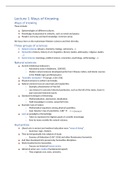Lecture 1 Ways of Knowing
Ways of knowing
These include:
Epistemologies of different cultures.
Knowledge incorporated in artworks, such as novels and poetry.
People’s every day and tacit knowledge. Common sense.
We focus here on the mainstream Western sciences and their diversity.
Three groups of sciences
1. Natural sciences (physics, chemistry, biology, astronomy …).
2. Humanities (history, history of art, linguistics, literary studies, philosophy, religious studies
…).
3. Social sciences (sociology, political science, economics, psychology, anthropology …).
Natural sciences
Ancient intellectual endeavors:
o Astronomy arose in Babylonia, 1200 BCE.
o Modern natural sciences developed partly from Chinese, Indian, and Islamic sources
in the Middle Ages and Renaissance.
“Scientific revolution” Europe, 1550-1700.
Physical universe is uniform and simple.
Natural sciences focus on universals and regularities.
o Example: phenomenon of free fall.
o Less interest in concrete historical particulars, such as the fall of the stone. Zoom in
past concrete historical events.
Standard techniques of theorizing:
o Mathematization, abstraction, idealization.
o Yield knowledge in concise, powerful forms.
Example: laws of nature.
o Mathematical equations among physical quantities.
o Isaac Newton’s law of gravitation, 1687
Laws as paradigms of knowledge.
o Taken to represent the highest grade of scientific knowledge.
o Even by many outside the natural sciences.
Humanities
Liberal arts in ancient and medieval education were “ways of doing”.
o Grammar, logic, rhetoric.
They turned gradually into subjects of study.
o Erasmus of Rotterdam (1467-1536) and other Renaissance humanists.
And then developed into present-day humanities disciplines.
World studied by the humanities.
o Focuses on historical human actors.
Historical actors are creative (fundamental aspect).
o They originate acts, texts, artworks.
, o Creation follows no rules – unpredictable and inexplicable. They seem to spring out
of nowhere.
Important methodological consequences …
Historical particularity:
o Every event and context is unique.
o We identify periods (e.g., Renaissance, Enlightenment), but then zoom in past these
categories. Humanities is interested in individual events.
Mistrust of generalization and idealization:
o Highest form of knowledge is intimate knowledge of particulars. Different from
natural sciences.
o Little or no use for scientific laws.
Main output: interpretations.
o Of acts, texts, artworks.
o Often embedded in theoretical frameworks.
Empathy, hermeneutics.
o We attempt to reconstruct the historical actor’s world of experiences and meanings.
o For example, we reconstruct what it was like for Michelangelo.
Objectivity of interpretation.
o We test interpretations against the text or other material.
Some complications
Both groups of disciplines are more diverse than is described.
Variety in natural sciences:
o Example: mechanism thinking in biology, not the laws of nature.
Variety in humanities:
o Linguistics, archaeology use some methods inspired by the natural sciences.
o Marxist historiography: belief in universal laws of historical development.
Question
How to …
o Conceptualize the differences between natural sciences and humanities?
o Analyze the diversity of the social sciences?
Answer: using the concepts of nomothetic and ideographic approaches.
o Proposed by Wilhelm Windelband (1848-1915), German neo-Kantian philosopher,
around 1894.
Nomothetic approach
What does the nomothetic approach consist in?
o Identifying regularities in the world.
o Formulating generalizations and laws to describe these regularities. For example,
Newton’s law of gravitation.
o Deriving explanations of observed outcomes from these generalizations and laws.
Typical of the natural sciences, but not unknown in humanities and social sciences.
Strength: nomothetic approach can …
o Identify similarities and structures that underlie apparently diverse cases.
o Yield sweeping, general knowledge.
o Yield economical knowledge. Knowledge that is simple and concise.
Weakness: nomothetic approach can …
, o Erase the specificity of outcomes
o Be reductive, mechanistic, positivistic.
Idiographic approach
What does the idiographic approach consist in?
o Understanding the meaning of contingent, unique, and often subjective outcomes.
Typical of the humanities (“sciences of the spirit”)
Strength: idiographic approach can …
o Reveal differences between apparently similar cases.
o Yield detailed, context-sensitive knowledge.
Weakness: idiographic approach can …
o Be blind to general factors that constrain outcomes.
Review: nomothetic/idiographic
Nomothetic approach: tendency to …
o Generalize.
o Explain outcomes by appeal to general rules.
Idiographic approach: tendency to …
o Specify.
o Understand the meaning of unique contingent, and often subject acts.
Tension between these approaches is particularly felt in the social sciences.
Social sciences
Youngest group of disciplines.
o Originated in late 19th century French and German debates on how to study societies.
o August Comte, Emile Durkheim, Max Weber.
Present-day disciplines: sociology, political science, economics, psychology, anthropology …
World of the social sciences contains …
o Human agents and institutions.
o Forms of behavior.
o Rationality and ritual.
o Cultures.
Social sciences feel the attraction of both natural sciences and humanities (idiographic and
nomothetic approach).
Economics, demography:
o Largely nomothetic disciplines.
o Predominantly mathematical investigation of underlying phenomena.
Cultural anthropology, political theory:
o Largely idiographic disciplines.
o Produce interpretations and ascribe meanings.
Diversity even within single disciplines.
o Example, psychology.
Nomothetic approach:
o Psychometric approach to personality.
o Categorizes individuals in terms of underlying universal traits or dimensions.
Idiographic approach:
o Sigmund Freud’s analysis of “kleine Hans”, a boy with a phobia of horses, 1909.
o Clinical notes running to 150 pages.
, Recapitulation
Characteristics of …
o Natural sciences, humanities, social sciences.
o Nomothetic and idiographic approaches.
This overview gives you a basis to …
o Interpret what knowledge each discipline can produce.
o Integrate the output of diverse disciplines.




